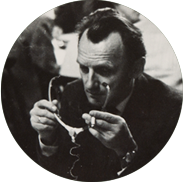Coffee and cigarettes coffee table
Rajmund Teofil Hałas
369,00 €
DIMENSIONS:
54 | 50 | 80 cm
MATERIALS:
Beech wood
- The finish can be customized upon request
- Estimated production time: about 3 weeks
COFFEE AND CIGARETTS TABLE
"I don't remember exactly when this project was created. We have had the prototype since the early 1960s. My husband used to call this little table 'COFFEE AND CIGARETTES'..." Mrs. Stanisława Hałasowa reminisced, showing us this marvel. The name of the presented piece of furniture was invented long before the premiere of Jim Jarmusch's legendary film (1986) and, of course, it fascinated us.
This small, lightweight, elegant, and slender coffee table is another design by Professor Rajmund Teofil Hałas, brought back to life by newmodel.org. It works excellently in both private spaces and in the arrangement of cafes and other service areas. The legs of the table, turned from beech wood, are finished with natural oil, while the melamine-coated white top has rounded edges covered with red PVC tape, just like the prototype from the old days.
The registered Community design is protected in all European Union countries.
DESIGNER

RAJMUND TEOFIL HAŁAS
He was born in Krobia, Greater Poland, into a family with a long tradition in the carpentry trade, which was initiated by his great-grandfather Jakub Węcławski in the mid-19th century. Jakub’s workshop was taken over by his son-in-law, Franciszek Hałas, who taught the trade to his son, Teofil. Teofil then built a furniture factory in 1922. Teofil’s sons, Zygmunt and Rajmund Teofil, continued the family tradition, with Rajmund Teofil obtaining a master carpenter diploma after studying at the Carpentry and Sculpture Gymnasium in Cieplice Zdrój.
In 1951, Rajmund T. Hałas began studying at the State Higher School of Fine Arts (PWSSP) in Poznań, at the Interior Architecture Department, and graduated with a diploma under the guidance of Professor Jerzy Staniszkis.
After his studies, he became involved in the furniture industry and led the Furniture Design Studio, which served the entire industry. At that time, he designed, among other things, the SHELF WITH ADJUSTABLE HEIGHTS (1959) and a group of chairs: RED – WHITE – BLACK (1957-62).
In 1960, he founded the Koło group with Czesław Kowalski (the author of Kowalski Wall Units), Leonard Kuczma, and Janusz Różański. This group initiated efforts to organize the Furniture Biennale in Poznań. After nearly twenty years (in 1978), the Organizing Committee of the 1st International Furniture Triennial was established.
In 1964, he received a scholarship to study at the Helsinki Institute of Industrial Arts, and a year later in the United Kingdom, where he met creators such as Alvar Aalto and Gordon Russell. His travels to the West resulted in the establishment of the Department of Industrial Design at PWSSP in Poznań in 1971, where he led the Inspiring Design Studio. He remained connected to the Poznań university throughout his extremely active life. After retiring as a professor, he served as a consultant in the Design Department and taught the history of architecture and design at the Faculty of Architecture and Design.
At the initiative of Marek Hałas, Professor Hałas’s nephew, the Carpentry and Biskupizna Museum was established in the former furniture factory buildings of his grandfather Teofil in Krobia. The museum is named after Rajmund Teofil Hałas.












